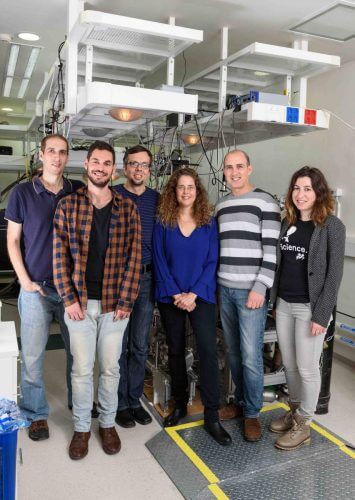Weizmann Institute scientists have measured for the first time, with an atto-second precision, the wave properties of ultrafast flashes of light that are created by the collision of electrons with atoms

One of the basic phenomena in quantum mechanics occurs when light hits matter and releases an electron from it. The process known as the photoelectric effect is for physicists a window into the quantum world, since the quantum state of a substance is reflected in those free electrons, making it possible to measure it. However, this process is one of the fastest in nature - it develops over several tens or hundreds of attoseconds (billionths of a billionth of a second), so any attempt to measure it directly is a huge challenge. Prof. Nirit Dudowitz and her research group at the Weizmann Institute of Science recently demonstrated an "inverted" outline for examining the quantum properties of emitted electrons.
"Physicists usually examine the quantum state of matter by extracting an electron using an energetic photon, but this approach leads to the loss of important information," says Prof. Dudowitz, from the Department of Physics of Complex Systems. "We completely reversed the order by using a process known as photo-recombination. While others measure the electron the photon releases, we measure the photon emitted when the electron collides with the atom and the two combine back. These are two sides of the same coin, but it turns out that the ability to measure the emitted photon - an extremely fast flash of light - provides access to information that was previously impossible to access."
These phases have already been calculated, but this is the first time they have been measured. It was an exciting experiment - to discover that we have the ability to directly measure such fundamental phenomena in physics"
Prof. Dudovitz's laboratory is particularly suitable for this type of research, as it specializes in advanced measurement methods that allow studying ultrafast phenomena with a resolution of attoseconds. Since the quantum state of matter is reflected in the wave properties of these fast flashes of light, the research group sought a way to measure these properties - the wavelength, its amplitude and the phase. Phase measurements are usually carried out with the help of an interferometer, a device found in almost every laboratory dealing with optical physics. The interferometer examines interference patterns of waves - such as light waves or waves of charged particles - and uses the interference patterns to reveal the nature of the quantum phenomena that created those waves.
One day about two years ago, one of Prof. Dudovitz's students, Doron Azuri, called her excitedly. An unexpected signal that appeared during a routine calibration test revealed a faint sign of interference between two attosecond flashes. This accidental discovery motivated the group members to make significant upgrades to the experimental setup, until they were able to reach a new level of accuracy. This is how the group realized that the interference they observed was the result of electrons uniting with their atoms in a photo-recombination process. They also realized that the method is so precise that it can be used not only to observe the reunion of the electron and the atom, but also to measure it. Azouri, Prof. Dudovitz and members of the research team Dr. Michael Kruger and Omer Kneller designed experimental setups aimed at measuring these wave characteristics. The findings of one series of experiments, recently published in the scientific journal Nature Photonics, show that the phase measurements allowed the group to fully measure the photoelectric effect.
"These phases have already been calculated - you can find these numbers in textbooks. But this is the first time they are measured directly and accurately. We measured them to an atto-second precision, and the measurements matched the calculations perfectly. It was a very exciting experiment - to discover that we have the ability to directly measure such fundamental phenomena in physics. It is hoped that our results will serve as a platform for the discovery of new ultrafast phenomena in more complex systems", Prof. Dudovitz concludes.
An atto-second is 10-18 the second; That is, the second billionth billionth
More of the topic in Hayadan:

One response
Can struggling with such a resolution improve LIGO?